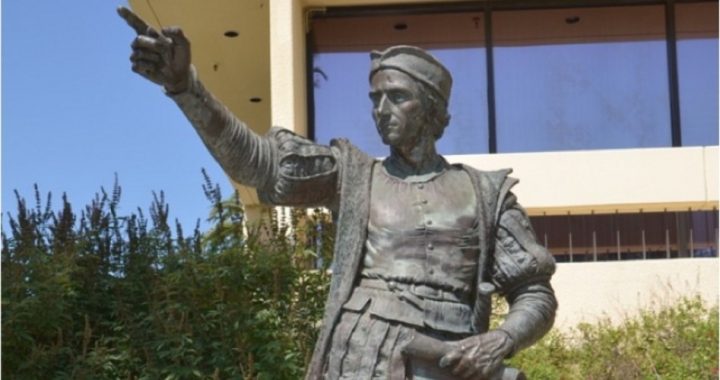
Pepperdine University, a Christian liberal arts college located in southern California, is the latest institution of higher education to join in the trashing of Christopher Columbus.
Pepperdine’s president, Andrew Benton, bowed to the wishes of a minority of the student population when he announced January 30 that a statue of Columbus Columbus on the Malibu campus would be removed and sent to Pepperdine’s Florence, Italy, campus. Benton explained his decision by saying “stories of conquest and the art associated therewith are painful reminders of loss and human tragedy.” The statue was removed last month.
The statue had been donated to the university in 1992 upon the 500th anniversary of Columbus’ discovery of the New World by Columbus 500 Congress. No doubt the group mistakenly believed that Pepperdine, with its reputation as a conservative Christian college, would appreciate the man responsible for first bringing the Christian faith to the New World.
Speaking publicly about the decision, Benton defended the statue’s removal. “I did not expect it to be popular. I didn’t do it to be popular. I did it because I believed it was the right thing to do.”
A small group of vocal students demanded the statue’s removal from the school’s amphitheater, calling it “a celebration of genocide and racial oppression.”
In an official statement, the university argued that Benton’s decision “recognizes the importance of compromise in creating a campus culture of unity and inclusiveness.”
Kaitlyn Pfingston, a graduate student spoke against the statue’s removal at a recent campus meeting on the subject, and particularly took issue with Benton calling it a “compromise,” saying, “That’s a concession. It’s not a compromise. Where is there any kind of compromise? He’s either removing [the statue] or he’s not.”
Pfingston also took issue with the assertion that Columbus was an instigator of genocide, and said that Benton’s action supports that false impression. “By [Benton] conceding [he] is effectively saying that those claims are accurate. And what that actually does is prevent other students who have the same opinion as me from speaking out because they don’t want to be labeled bigoted or indifferent to human suffering or indifferent to indigenous populations.”
Jens Cole, a junior at Pepperdine, dismissed the argument that most students were either indifferent to Benton’s action, or actually opposed it. “I think you have to pay respect to the people who were siding toward it being offensive and inappropriate.”
Really? What would Cole think about “offending” those who see Columbus as a symbol of the good of Western Civilization? Why are their feelings and views not as important as those who wanted the statue removed?
Hannah Fleming, another student at Pepperdine, illustrates why the Left will never be satisfied, and will always find something else to be “offended” about. While she admitted that “most people are indifferent,” Fleming, who said she grew up on an Indian reservation, even opposed the decision to send the statue to Italy, arguing that “removing [the statue] but still having it associated with the university is a little bit controversial.”
The denigration of Christopher Columbus by secular progressive universities is unfortunate enough, but for a Christian university to jump on the trash Western Civilization bandwagon is particularly disturbing. The college is associated with the very conservative churches of Christ in the United States, and was founded in 1937 in south central Los Angeles by George Pepperdine, and moved to Malibu after some radicals in the 1960s threatened to burn down the campus. Pepperdine had earned his fortune with the Western Auto Supply company, begun with an investment of only $5. When he founded the college, he said he had two major objectives. “First, we want to provide first-class, fully accredited academic training in the liberal arts.”
“Secondly, we are especially dedicated to a greater goal (emphasis added) — that of building in the student a Christ-like life, a love for the church, and a passion for the souls of mankind.” (Emphasis added.)
Ironically, this was the very goal shared by the man that the present president of Pepperdine has decided to trash — Christopher Columbus.
While depicted in modern popular culture as a man motivated primarily for gold and spices, this was only a part of his larger motivation. It was his desire to find enough wealth to finance a “crusade” to free the Holy Land from Islamic domination and “conquer the Holy Sepulcher [Christ’s empty tomb]; for this I urged Your Highnesses,” Columbus told King Ferdinand and Queen Isabella of Spain, “to spend all the profits from this enterprise on the conquest of Jerusalem.” (Emphasis added.)
The Muslims had conquered Constantinople in 1453, completing their multigenerational conquest of the Christian world in the East, including the Byzantine Empire and the lands where Jesus had lived, died, and risen from the dead. Columbus, after careful study of the Old and New Testaments, along with some readings in the works of the historian Flavius Josephus, and the noted church “father” Augustine, had concluded that the city of Jerusalem needed to be in Christian hands before the Lord would return.
Specifically, Columbus believed the biblical prophecies would dictate the reconstruction of the Temple first. And Columbus was convinced that his present mission was part of the overall plan of God to see this was accomplished.
Columbus did not set out from Spain to enslave American Indians, since he was ignorant of their very existence. After reading of the travels of the Venetian Marco Polo, Columbus was inspired to reach the Grand Khan, the Mongol ruler of China. The Chinese monarchs had expressed to Polo’s family some interest in the Christian faith, leading Columbus to hope for the conversion of China, so they could then combine forces and drive the Muslims out of the Holy Land.
In other words, Andrew Benton, president of Pepperdine, a college founded with a “passion for the souls of mankind,” has removed the statue of the man who shared that passion.
Nationally conservative syndicated talk show host Dennis Prager, who launched a petition (which has garnered over 10,000 signatures) to keep the statue at Pepperdine, said, speaking of Pepperdine, “Once regarded as one of the few sensible universities in the country, that appears to be a thing of the past. They have gone Left. They are getting rid of their statue of Christopher Columbus for reasons of ‘diversity.’ The university president’s letter of explanation is an embarrassing bow down to political correctness.”
Benton said that the statue was a “painful” reminder of “loss and human tragedy,” but Prager disagreed, saying he believed that “Christopher Columbus should be venerated for his brave and heroic expedition. Columbus’ daring journey to North America led to the creation of the freest and most prosperous nation in human history.”
William Fowler, a history professor at Northeastern University, took issue with Benton’s comments about Columbus. “The issue of genocide is a term [Columbus] would not have understood. To be guilty of genocide [Columbus] would have had to have intent. What evidence do we have of his ‘intent’ to commit genocide?”
On the contrary, Columbus’ intent was to take the gospel to Asia, and when he first arrived in the islands off the coast of North America, he believed he had reached the outskirts of Asia. No logical person could believe that his intent to was to commit genocide upon the very people he was hoping to convert to Christ, and help European Christians re-take the Holy Land.
Considering that Columbus died in 1506, it is difficult to argue that he was responsible for any genocidal activity which took place after that date. As George Grant wrote in The Last Crusader: The Untold Story of Christopher Columbus, “To be sure there were perverse abuses … but heap all that upon the shoulders of one man — a man who unleashed upon the Americans far more good than woe — is patently absurd…. Far from being a racist, he proved time after time to be overly enamored with the native populations he encountered.”
While the Spanish no doubt were guilty of abuses, they did not commit genocide in the New World. The biggest killer of the indigenous population was not the sword of the conquistadores, but rather smallpox and measles. While Columbus certainly unwittingly made this possible by achieving contact with peoples of the Western Hemisphere, he can hardly be held responsible for it. Nor could other Europeans who followed him, who had no understanding of the transmission of these diseases.
Soon after his contact with the native peoples, Columbus wrote, “I believe that they would become good Christians very quickly.”
That hardly sounds like a man who wished to commit genocide, nor does it sound like a man that the president of a college founded out of passion for the souls of mankind would want to denigrate.
Steve Byas is a professor of history at Randall University, a liberal arts college in Moore, Oklahoma, associated with the Free Will Baptist denomination. He has written on Columbus and other historical figures he believes have been unfairly treated in modern times in his book History’s Greatest Libels.



